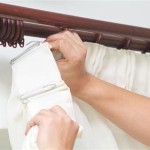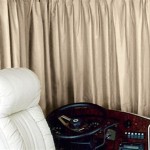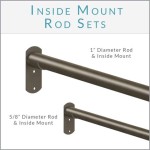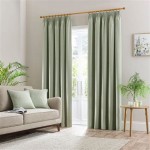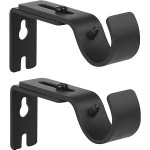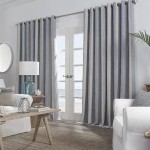Enhancing Window Aesthetics and Functionality with Self-Adhesive Curtain Tie Backs
Self-adhesive curtain tie backs represent a practical and aesthetically versatile solution for managing curtains and draperies. These accessories offer a damage-free alternative to traditional tie backs requiring drilling or screwing into walls or window frames. They are particularly advantageous for renters, individuals seeking temporary solutions, or those wishing to avoid permanent alterations to their living spaces. This article explores the various aspects of self-adhesive curtain tie backs, including their types, advantages, installation, removal, and considerations for optimal usage.
Types of Self-Adhesive Curtain Tie Backs
Self-adhesive curtain tie backs are available in a diverse range of materials, designs, and functionalities to cater to varied aesthetic preferences and curtain weights. Understanding the available options is crucial for selecting the most suitable tie backs for a specific application.
Hook and Loop Tie Backs: These typically consist of two components: a self-adhesive hook section that adheres to the wall or window frame and a loop strap that wraps around the curtain and fastens to the hook. Hook and loop tie backs offer adjustability, allowing for varying degrees of curtain gathering. They are often made of durable nylon or polyester materials.
Magnetic Tie Backs: Magnetic tie backs utilize magnets to hold the curtain in place. One part of the magnet is attached to the wall or window frame with adhesive while other magnet is attached to a decorative element that wraps around the curtain. These tie backs are characterized by their ease of use and aesthetic appeal. They come in various shapes, sizes, and finishes, including metallic, fabric-covered, and decorative designs. However, their holding strength may be limited to lighter-weight curtains.
Adhesive Button Tie Backs: These tie backs are characterized by a small, decorative button attached to an adhesive backing. The curtain is looped around the button to create a gathered effect. Adhesive button tie backs are often chosen for their discreet appearance and ease of installation. However, their holding capacity is generally lower than other types of self-adhesive tie backs.
Twisted Rope Tie Backs with Adhesive Mounts: These tie backs combine the visual appeal of traditional rope tie backs with the convenience of self-adhesive mounting. A decorative rope or cord is attached to adhesive-backed hooks or buttons secured to the wall. The rope is then used to gather and hold the curtain. These offer a blend of functionality and style, suitable for various interior design schemes.
Advantages of Using Self-Adhesive Curtain Tie Backs
Self-adhesive curtain tie backs present several compelling advantages compared to traditional curtain tie back solutions. These benefits contribute to their increasing popularity across diverse residential and commercial settings.
Damage-Free Installation: The primary advantage of self-adhesive tie backs lies in their damage-free installation. Unlike traditional tie backs requiring drilling holes, self-adhesive versions rely on strong adhesives to secure to surfaces. This eliminates the risk of damaging walls, window frames, or other surfaces, making them ideal for rented properties or situations where permanent alterations are undesirable.
Ease of Installation: Installing self-adhesive tie backs is a straightforward process that typically requires minimal tools and expertise. Most products come with clear instructions and can be applied within minutes. This ease of installation makes them an accessible option for individuals of all skill levels.
Versatility in Placement: Self-adhesive tie backs offer flexibility in placement. They can be positioned at various heights on the wall or window frame, allowing for customized curtain draping and gathering. This versatility enables users to achieve their desired aesthetic and functional outcomes.
Removability: While providing a secure hold, self-adhesive tie backs are also designed for relatively easy removal. Most adhesives can be carefully peeled away from surfaces without leaving residue or causing damage. This removability allows for adjustments, relocations, or removal when no longer needed.
Cost-Effectiveness: Self-adhesive curtain tie backs are generally more cost-effective than traditional tie back options. The lower cost is attributed to the simplicity of design, manufacturing, and installation. Additionally, eliminating the need for professional installation services further reduces overall expenses.
Aesthetic Variety: As mentioned previously, a wide range of designs, materials, and finishes are available in self-adhesive tie backs. This extensive selection ensures that users can find tie backs that complement their existing interior decor and personal style.
Installation, Removal, and Best Practices
Proper installation and removal techniques are essential for maximizing the effectiveness and preserving the integrity of both the tie backs and the surfaces they are applied to. Adhering to best practices ensures a long-lasting and aesthetically pleasing result.
Surface Preparation: The most critical step in installing self-adhesive tie backs is preparing the surface. The surface must be clean, dry, and free of dust, grease, or other contaminants. Wiping the surface with isopropyl alcohol is recommended to remove any lingering residue and promote optimal adhesion. Some surfaces, particularly certain types of paint or wallpaper, may require additional preparation, such as light sanding to create a slightly roughened surface for better adhesion.
Adhesive Application: Carefully peel off the protective backing from the adhesive pad or strip. Position the tie back in the desired location and firmly press it against the prepared surface. Apply consistent pressure for the recommended duration, typically 30 seconds to one minute, to ensure a strong initial bond. Avoid repositioning the tie back after initial placement, as this can weaken the adhesive bond.
Curing Time: Allow the adhesive to cure fully before subjecting the tie back to any significant weight or stress. Curing time typically ranges from 24 to 72 hours, depending on the type of adhesive and environmental conditions. During this period, avoid hanging heavy curtains or applying excessive force to the tie back.
Curtain Weight Considerations: Self-adhesive tie backs have limitations regarding the weight they can support. Consult the product specifications to determine the maximum weight capacity of the chosen tie backs. Avoid using them with excessively heavy curtains, as this can lead to premature failure of the adhesive bond.
Removal Techniques: To remove self-adhesive tie backs, gently peel away the edge of the adhesive pad or strip. Use a slow and steady motion to avoid tearing the adhesive or damaging the underlying surface. If the adhesive is particularly stubborn, applying gentle heat from a hairdryer can soften it and make removal easier. Be mindful of potentially heat-sensitive surfaces like vinyl wallpaper, where excessive heat could cause damage.
Residue Removal: After removing the tie back, some adhesive residue may remain on the surface. Common methods for removing adhesive residue include using a damp cloth with mild soap and water, applying a specialized adhesive remover, or gently rubbing the residue with a clean cloth dampened with rubbing alcohol. Always test any cleaning solution in an inconspicuous area first to ensure it does not damage the surface.
Reapplication: Some self-adhesive tie backs are designed for reapplication using replacement adhesive strips or pads. Ensure that the replacement adhesive is compatible with the tie back and the surface it will be applied to. Follow the same installation procedures as with the original adhesive.
Environmental Factors: Environmental factors such as humidity and temperature can affect the performance of self-adhesive tie backs. High humidity can weaken the adhesive bond, while extreme temperatures can cause the adhesive to become brittle. Consider these factors when selecting tie backs and installing them in areas with fluctuating environmental conditions.
Surface Compatibility: Not all surfaces are equally suited for self-adhesive tie backs. Smooth, non-porous surfaces such as glass, tile, and metal generally provide the best adhesion. Textured surfaces, such as certain types of wallpaper or painted walls, may require additional preparation or a stronger adhesive to ensure a secure bond. Avoid applying self-adhesive tie backs to surfaces that are peeling, flaking, or otherwise unstable.
Regular Maintenance: Periodically inspect the self-adhesive tie backs to ensure they remain securely attached. If any signs of loosening or detachment are observed, reinforce the adhesive bond by reapplying pressure or replacing the adhesive pad or strip. Regular maintenance can prolong the lifespan of the tie backs and prevent unexpected failures.

Pair Adhesive Curtain Tie Backs Holdbacks No Hole Pull Wooden Accessory Oak

Dodamour 2 Pack Curtain Holdbacks No Drill Self Adhesive L Shaped Holder Drapery Tiebacks For Home Office Decorative White

Pair Adhesive Curtain Tie Backs Holdbacks No Hole Pull Wooden Accessory Oak

Bobasndm Curtain Holders Self Adhesive Holdbacks L Shaped Tiebacks Hooks For Drapes Nordic Style Ties Wall Tie

Bobasndm Curtain Holders Self Adhesive Holdbacks L Shaped Tiebacks Hooks For Drapes Nordic Style Ties Wall Tie

Dodamour 2 Pcs Plastic Curtain Holdbacks For Wall Self Adhesive Hooks Organize And Decorate L Shape Retractable Tiebacks Window

2 X Curtain Tie Back Hooks Stick On Self Adhesive Sticky Tassel Holders Tiebacks

2 X Curtain Tie Back Hooks Stick On Self Adhesive Sticky Tassel Holders Tiebacks

Dodamour 2 Pack Curtain Holdbacks No Drill Self Adhesive L Shaped Holder Drapery

Dodamour 2 Pcs Plastic Curtain Holdbacks For Wall Self Adhesive Hooks Organize And Decorate L Shape Retractable Tiebacks Window

